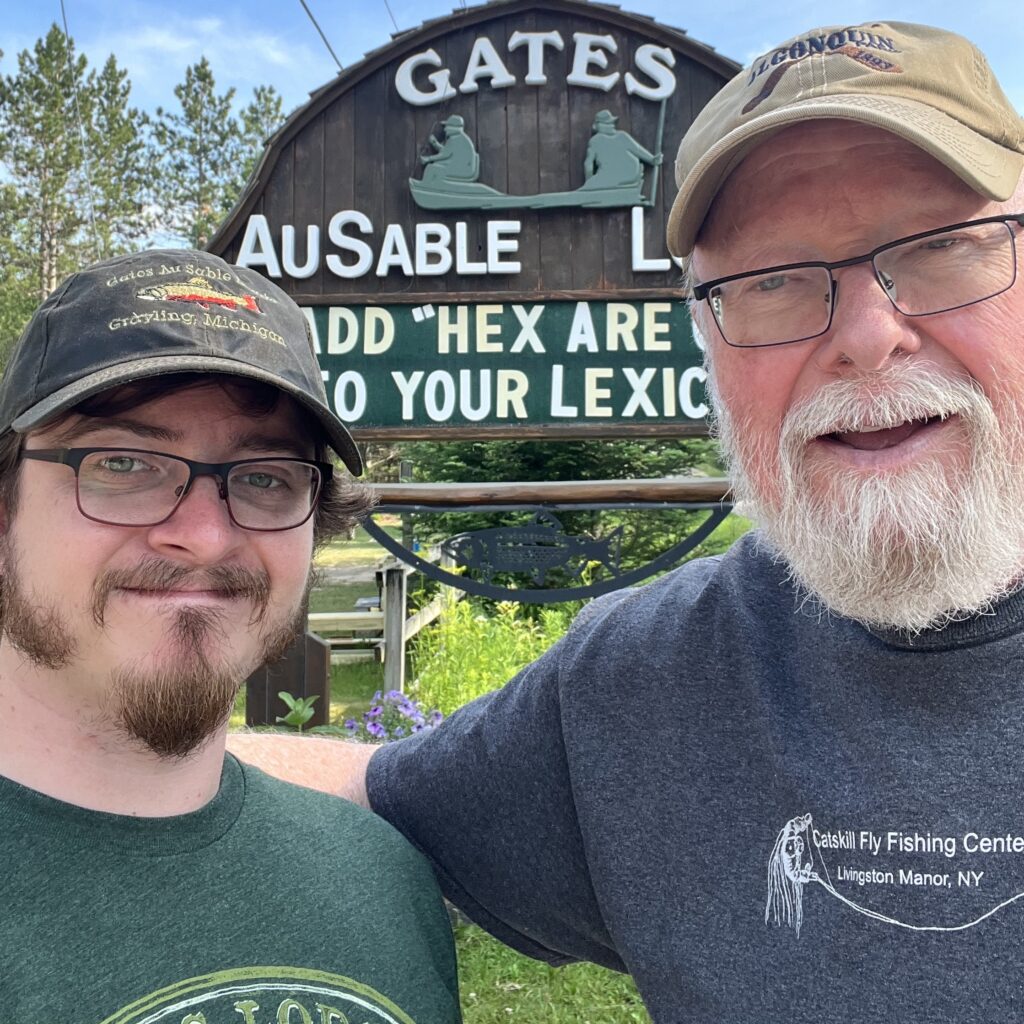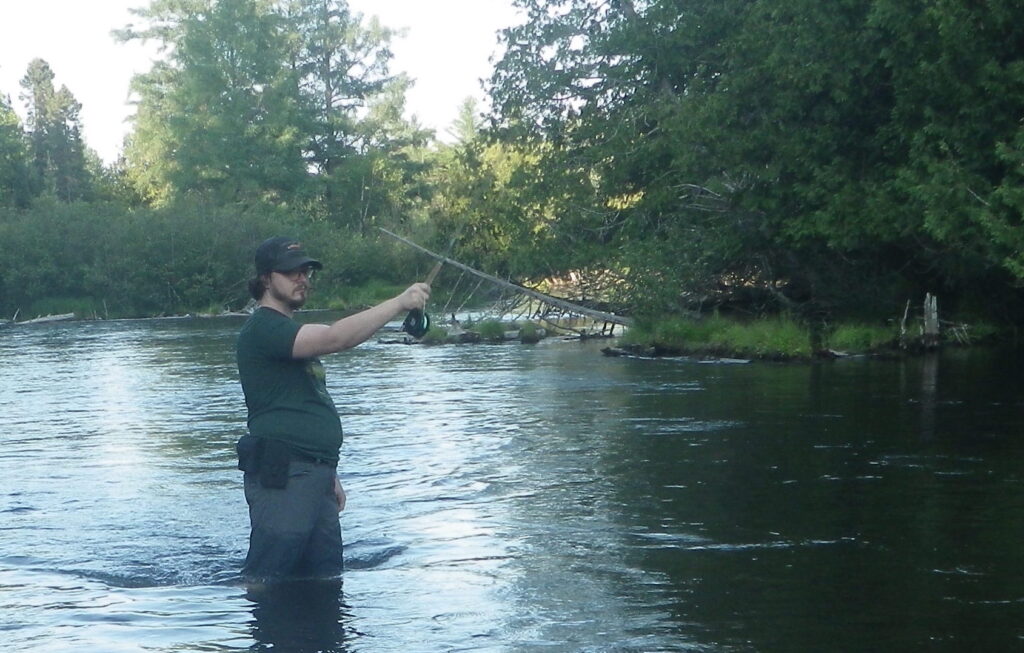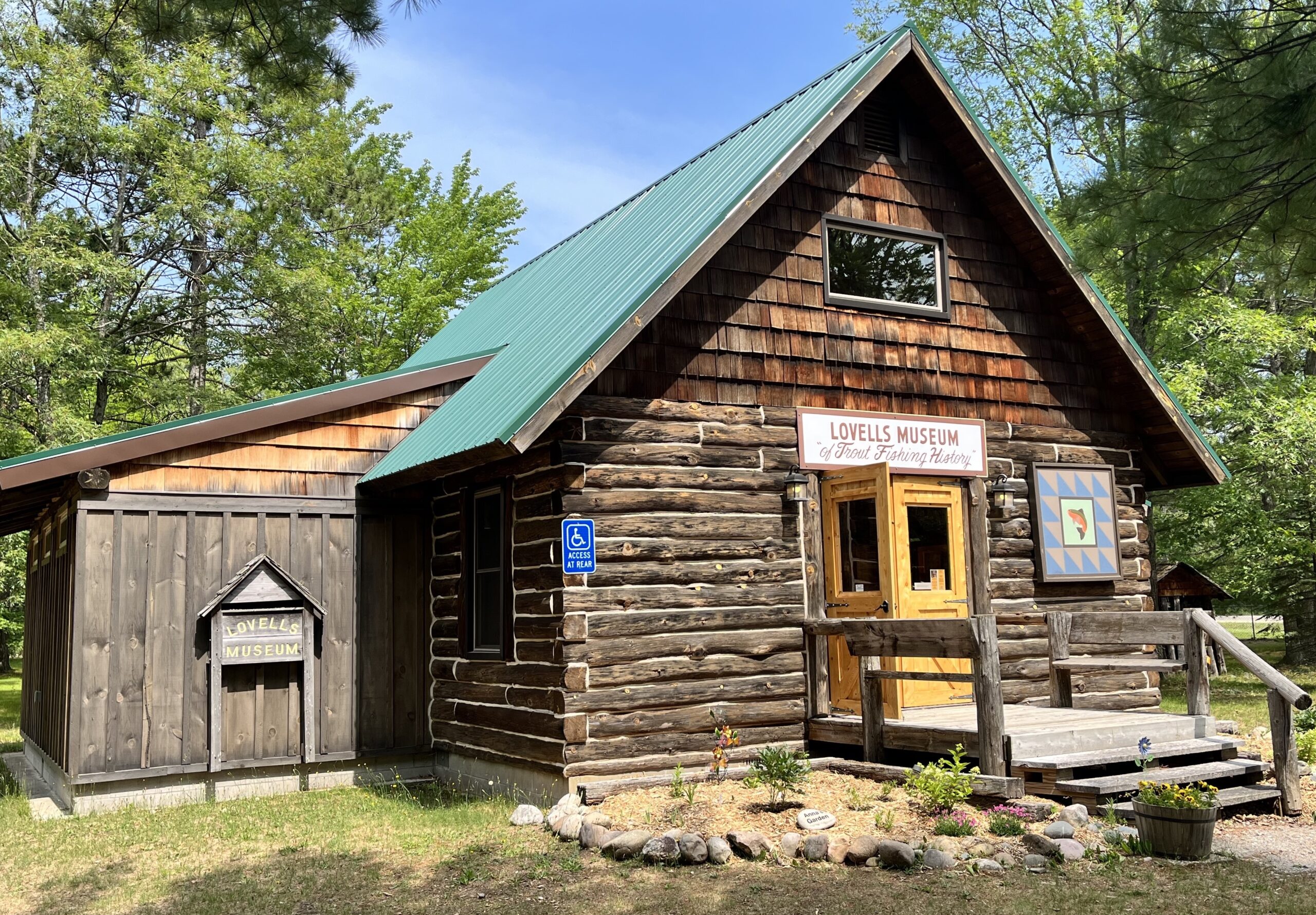Fly angling and writing are two current seams in the same river–at least for me. When I finally fulfilled a dream sustained over six decades of fishing the Holy Water of the Au Sable River, ‘Up North’ in Michigan, it was as much for its rich literary and angling heritage as it was for its exemplary fishing.
I booked reservations at Gates Au Sable Lodge not only because of its reputation for hospitality and accommodation but because its owner, Josh Greenberg, is a fine writer who has published an eloquent memoir, Trout Water. Josh has intimate and comprehensive knowledge of the Au Sable gained through many years of living in the area and guiding on the river. But what I most admire about his book are the anglers–both companions and mentors–he remembers and honours with such compassion and depth of feeling. His extensive library housed at the lodge–impressive for the quality as well as the quantity of its editions–pleased me as much as the opportunity to catch trophy trout.

My dream of fishing the Au Sable began taking shape in the 1960s when Cable TV came to my hometown of London, Ontario and I started watching Michigan Outdoors on Channel 7 out of Detroit. Hosted by Mort Neff, the show originated in 1951, airing in prime time on Thursday evenings. These many years later I watch Michigan Out of Doors on PBS with amiable co-hosts Jimmy Gretzinger and Jenny Olsen Ciolek. The show has become an entry in the album of memories I have cherished throughout my life as a loyal fan of the Tigers, Pistons, Lions and, especially, the Red Wings.
I have long treasured a small, tattered black and white photograph of a smiling five-year old boy standing in front of the Christmas tree. I’m smiling because Santa left me a Detroit Red Wings jersey (red with its distinctive white winged wheel), red pants with white stripe down the sides, gloves, shin pads and red socks with horizontal white stripes around the calves, along with a hockey stick and pair of skates. I’m happy because Santa knew my hero was Gordie Howe. The player who eventually became known as Mr. Hockey was my first hero and the primary reason I have always loved the sport.
As much as fly fishing has brought my eldest son Dylan and me closer together, hockey provides the vocabulary of love that binds me to my youngest son, Robertson, who like his dad played the game in his youth and remains devoted to what is known as Canada’s national pastime.
When I was ten years old I was devastated to watch the Red Wings lose to the Chicago Blackhawks at the Olympia. History repeated itself half a century later when I saw the Red Wings lose to the Toronto Maple Leafs when I took Robertson to a game in the final season of the Joe Lewis Arena. We have plans to take in a rematch at Little Caesars Arena.
My dream of fishing the Au Sable seemed to alight on dead water when I phoned Josh in early spring to make reservations. ‘Sorry we’re booked through June,’ he apologized.
I told him I was hoping to realize a dream I had guarded since childhood and that I wanted to share it with Dylan, who had recently taken up fly fishing. Josh hesitated momentarily before confirming that he had a cancellation for the last week in June.
‘That’s wonderful because it would fall on my seventy-second birthday,’ I chirped.
‘Seems like it was made to be,’ Josh replied. ‘See you then.’
. . . . . . .
It was imperative for me to share the fulfillment of my long-held dream with my eldest son. I introduced him and Robertson to fishing when they were boys. For ten days at the height of summer over several years, my wife Lydia and I rented a rustic island cottage on a small shallow lake in the Kawarthas, a hundred kilometres northeast of where I attended university in Peterborough. The lake, known locally as Bass Lake—appropriately, as it turned out—supported healthy populations of smallmouth and largemouth bass, as well as panfish.
I usually fished alone by canoe in the afternoons while the boys remained with their mom and our black lab Leia (named by Dylan after the Star Wars princess) at the cottage. Swimming off the dilapidated dock, tent-building with fallen evergreen branches and target shooting with Dylan’s pellet rifle were usually on their agenda.
In the evenings, after early barbecue suppers, I fished with my sons from a fourteen-foot aluminum boat, powered by a touchy four-horsepower Johnson outboard motor. We tossed crankbaits, jerkbaits, even spinnerbaits, not to mention plastic leeches and minnows, soaked in some magic elixir advertised to transform bass into ravenous gluttons.
Although Dylan was barely in his teens (Robertson is four years younger), both boys learned to cast and how to handle fish after they hit. The other photograph I most cherish shows Dylan in the stern of the boat smugly holding a fourteen-inch smallmouth by the lip, while Robin struggles mightily in the bow trying to grasp with both hands his sixteen-inch largemouth by the tail. The joy is palpable.

I had barely started fly fishing, let alone pledge allegiance to the catch-and-release ethic, so it was catch-and-eat. The boys loved chowing down on nighttime snacks of fresh bass fritters—dipped in egg yolk and rolled in cornmeal before being deep fried to a crispy golden brown in hot oil.
At the time Dylan was studying karate—at which he grew proficient, eventually attaining a black belt and competing in Kyoto. He acquired the habit of wearing a patterned kimono while fishing. I wonder whether the philosophy he learned through the ancient Japanese martial art will ever be transferred to fly fishing, which he took up a couple of years ago just as he turned thirty. Conversely, Robertson has yet to show the slightest bit of interest.
Dylan decided to take up the contemplative recreation not because of any deep passion for fishing, but because he wanted to investigate why it had hooked his dad at the meridian of life. I also believe it came from a desire to stay connected with me after Lydia and I separated and subsequently divorced while Dylan was attending university.
I find this interesting because the practice of catching fish is not primarily what attracted me to fly fishing. Rather, I was drawn to the recreational sport because of its long tradition of literature, visual art and music. This cultural tradition is a direct outgrowth of the history of fly fishing which, in turn, has been shaped and influenced by the writing, art and music it has inspired. It is toward this convergence of cultural currents that I cast my imagination.
. . . . . . .
Despite its long smooth glides, its gravel bottom stretching for miles, its proliferation of cedar sweepers where the big trout lie, its quietude, serenity and beauty that rewards contemplative wading, I knew the Au Sable’s fishing would be challenging, both for me and for Dylan. But my dream would not be denied. As expected, we arrived at the height of the legendary Hexagenia limbata hatch, which Josh evocatively describes in his book as the ‘hex fermata.’
I had no interest in blind-casting my seven-foot, nine-inch, five-weight Sweetgrass bamboo rod to the sound of large voracious trophy Brownies in tar-black darkness while nursing a tender knee awaiting transplant surgery. I also knew that Dylan wasn’t up to the task, just yet. I reasoned that tossing Isonychia dry flies to modest Brookies and Rainbows in the gloaming would be the ticket.
The weather, however, had other plans. The river was pounded by four inches of rain the day before we arrived and was drenched again at the mid-point of our stay by torrential rain accompanied by hail.
None of this mattered. Not one iota.
Josh had assigned Mark Hendricks, an experienced guide who was a retired firefighter from Detroit, to instruct Dylan on the intricacies and nuances of fly fishing. In his youth Mark was a promising hockey player–so good in fact that he won a scholarship to Boston College only to be derailed by a couple of knee surgeries–the Bobby Orr curse. My dad was a firefighter for thirty-five years, so Dylan and I really hit it off with Mark. I told him that all I expected was for my son to return home a better fly angler than he was when he left. And, like a long fine cast, Mark delivered with generosity, humour and grace.
However, it was the literary and fly angling connections to the Au Sable that made the dream-come-true adventure significant and memorable. After all, anglers inclined to cast their imaginations on literary waters feel right at home in a place where the most popular craft ale is Two Hearted IPA.
When we weren’t casting lines on the river, Dylan and I went on short jaunts to Walloon Lake and Horton Bay (pop. 512) to trace Ernest Hemingway’s faint footprints. The original family cottage has been renovated so extensively that it bears little resemblance to anything the writer would recognize. Similarly, the quaint hamlet of Hemingway’s day has become a millionaire’s row of summer estates. Still, I was delighted to meet a direct descendent of a family Hemingway mentions in one of his Nick Adams stories in the Red Fox Inn Bookstore, which specializes in all things Hemingway including books and memorabilia. She was a sweetheart who mused about the writer as if she had known him personally so many years ago.
Dylan and I travelled to Mayfield in honour of Leonard Halladay, inventor in 1922 of the classic Adams dry fly (a versatile, impressionist trout deceiver I use religiously). Hallady named the fly after Charles F. Adams, a lawyer from Ohio and longtime angling buddy who first cast it on the nearby Boardman River, another one of northern Michigan’s celebrated trout waters. Heading down the road to the public library in Kingsley to see a display–featuring a rare original Adams fly tied by Halliday along with some archival photographs–was akin to worshipping at a shrine. It was heartwarming to meet a young library technician who took such pride in the display while outlining the importance of Halladay to the area. ‘He put us on the map,’ she enthused.
We made the rounds of Grayling, the epicentre of where the late, esteemed Jim Harrison was born and lived off and on for many years before he joined fellow Michigan-born writer Thomas McGuane in Montana and began dividing his time between Big Sky Country and Arizona borderlands. We visited Lovells Museum of Trout Fishing History, on the Au Sable’s North Branch, where we learned about George Griffith, writer, conservationist, inventor of the Griffith’s Gnat midge pattern and one of sixteen founding members, as well as a director, of the inaugural chapter of Trout Unlimited. (Is it any wonder Doug ‘Grizzly Bear’ Peacock–Vietnam War veteran, eco-author, filmmaker, wildlife activist and inspiration for Edward Abbey’s George Washington Hayduke in The Monkey Wrench Gang–was born and raised a couple of hours drive south of here?)

I talked to a bookish fly angler at the lodge about Michigan poets Michael Delp and Chris Dombrowski, naturalist and angling writer Jerry Dennis and mystery writer Ronald Weber. He told me about plans the Lodge had of hosting a fly angling writers’ symposium which, sadly, had to be postponed because of the Covid pandemic. Michigan continues to produce a new generation of angling writers as confirmed by Callan Wink who, like Harrison, McGuane and Dombrowski, lit out for Montana to write while working as a fishing guide.
Before turning in every night, I read a few pages of Cold Hearted River, angling mystery writer Keith McCafferty’s homage to Hemingway, portions of which are set on the comely Au Sable. As a teenager Keith spent his summers doing reclamation work on the river to protect and safeguard its trout fishery.
It was impossible for me to wade into the Au Sable without feeling the friendly presence of these literary angling companions, past and present, directing my casts to where wily trout aught to be. By viewing fishing this way the magic never evaporates because success is not measured by the number and size of fish caught, but rather by the richness and depth, texture and colour, mood and atmosphere of the experience. Who needs fish when warmed and comforted under a duvet of mystery?
What I will remember most affectionately, however, are the late evenings Dylan and I spent sitting on a bench overlooking the river, enjoying fine Honduran cigars and ten-year old Ardbeg–revered as the peatiest, smokiest and most complex of all the Islay malt whiskies, despite its subtle notes of natural sweetness–listening to a softly cooing owl and a pair of serenading whippoorwills while talking about the things fathers and sons contemplate in a land where lifelong angling dreams really do come true.